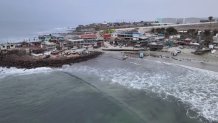Just 10 minutes south of Rosarito Beach -- and 45 minutes south of the U.S.-Mexico border -- is the village of Popotla, a small fishing town. Every morning before sunrise, local fishermen get ready for a day's work. They load boats that are meant to carry just a few people, plus a day’s catch.
But Aaron Heitke, chief of the U.S. Border Patrol, San Diego Sector, said some of these boats in fishing towns like this up and down Baja California are carrying migrants desperate to cross into the United States.

NBC 7 spoke to fishermen that work in Popotla. We asked if they knew anything about human smuggling boats leaving from the area.
Get top local stories in San Diego delivered to you every morning. Sign up for NBC San Diego's News Headlines newsletter.
”There are other issues here but I’m not going to get into it, you know?” one fisherman said. Pressed further about why he’s reluctant to talk about human-smuggling boats, he said, “I have to protect myself and my coworkers.”
It’s that danger that human and drug smugglers bring to the region that has authorities -- on both sides of the border -- pleading with migrants to avoid the dangerous ocean crossings.

On May 2, a trawler-style vessel carrying 33 people crashed off Point Loma during an attempt to smuggle undocumented immigrants into the U.S. A Navy sailor who jumped into the water to try to help described the scene to NBC7: “With the waves going up and down, you're only able to see maybe 10 to 15 feet around you. The water was unforgiving.”
Local
The accident sent everyone into the cold, rough waters, killing three people. Antonio Hurtado, 39, a U.S. citizen, is accused of piloting the 40-foot vessel.
Another boat was also intercepted that day. Border Patrol agents caught the migrants once they got to shore. NBC7 spoke with one man who was on that boat. Speaking in Spanish, he described his journey as awful. He said it was really tough and he wouldn't recommend it to anyone. He said he spent $16,000 for the attempt, all for nothing.
According to U.S. Customs and Border Protection, maritime apprehensions in the San Diego area increased 92% between fiscal year 2019 and fiscal year 2020. With 1,101 arrests so far in 2021, the region is on track for a 40% rise in incidents at sea.
Heitke said that, so far in 2021, five people have died trying to cross into San Diego waters from Mexico.
“Right now, it's one of our No. 1 priorities," Heitke said. "We've had too many deaths. One death is too many.”
Pres. Joe Biden ended further construction of the border wall along the U.S.-Mexico border by terminating former Pres. Donald Trump’s national emergency declaration. But other policies, such as the Title 42 pandemic policy. which calls for immediately expelling people caught crossing the border without documents, remain in place.
As U.S. officials have made physical land barriers tougher, smugglers have become more creative, driving up the cost of entry. Heitke said that people are paying anywhere from $12,000 to $20,000 to be smuggled by sea, compared to $5,000 to $8,000 per person by land.
“We are prosecuting all the smuggling cases that we can, both on the land and the water, but we are very aggressively prosecuting the maritime angle to slow that down,” Heitke said. “It's hard to say right now if that’s working. It’s a little too early to tell.”
Heitke worries that the situation could become more dire and deadly this summer. With warmer weather and water, more people might be tempted to make the journey, relying on smugglers that often have little experience on the water.
“It's easier for them to blend in with the legitimate traffic, so we are trying to get it stopped or slowed down going into the summer.” Heitke said.



